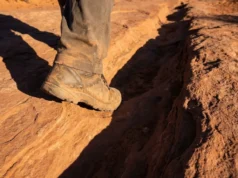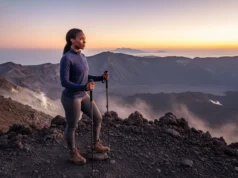In this article
Planning a day hiking trip to Glacier National Park can feel more like a complex military operation than a vacation, thanks to competitive reservations, packed trailheads, and ever-changing conditions. This guide moves beyond simple lists of the best hiking trails in Glacier National Park to provide a field-tested, strategic framework, ensuring you can navigate the logistics and spend your time experiencing the park’s most extraordinary hikes.
- Mastering Logistics First: Learn the tactical approach to securing vehicle reservations and conquering the “parking gauntlet” at key trailheads like Logan Pass.
- Strategic Trail Selection: Discover the premier day hikes organized by park region, complete with our unique “Hike Planning Packet” for each to ensure you’re prepared for the varied terrain.
- Advanced Fieldcraft: Elevate your skills with essential, expert-level advice on bear safety, responsible hiking, and reading the park’s dynamic conditions.
- Actionable Itineraries: Use our master comparison table and contingency plans to build a flexible, rewarding hiking itinerary that matches your skill level and includes the best trails in Glacier National Park.
Why Is Logistical Planning So Critical in Glacier?
This section will address the primary barriers to entry that hikers face, focusing on the mandatory systems and intense competition for access that define a modern Glacier National Park trip.
How Does the 2025 Vehicle Reservation System Actually Work?
Successfully hiking in Glacier National Park begins long before you reach the trailhead; it starts with navigating the park’s mandatory vehicle reservation system. During peak season, this system is a non-negotiable prerequisite for accessing the park’s crown jewels, including the west side of the Going-to-the-Sun Road, the remote North Fork, and the iconic Many Glacier valley. Entry into these zones without a reservation during specified hours is simply not permitted.
These coveted passes are available through The official timed-entry reservation portal and are released in two distinct windows. For meticulous planners, reservations become available on a 120-day rolling basis. For more spontaneous trips, a very limited number of next-day reservations are released at 7 PM Mountain Time the evening before entry, though competition for these is incredibly fierce. However, a “service reservation loophole” exists: holding a reservation for lodging, camping at designated campsites, or a commercial tour—such as a boat ride or horseback outfitter—within a specific access zone also serves as your vehicle reservation for that area.
What Are the Realities of Parking at Major Trailheads?
Securing a vehicle reservation is only the first hurdle; the next is the “parking gauntlet.” Trailhead parking at popular locations is a significant challenge that demands its own strategic approach. For example, the Logan Pass parking lot, the coveted trailhead for the Highline Trail, regularly fills to capacity before 6:30 AM during the summer months. You can check the Real-time status of the Logan Pass parking lot to see the competition for yourself. This isn’t unique to Glacier; we’ve seen similar logistical challenges at the Grand Canyon’s Bright Angel Trailhead.
[PRO-TIP] For the 2025 season, the Many Glacier area will undergo major construction, heavily restricting personal vehicle access. Most hikers will be required to use a mandatory shuttle system to reach the trailheads for the Grinnell Glacier and Iceberg Lake hikes, making advance planning absolutely essential.
At the west end of the park, the Avalanche Lake trailhead area, which provides access to both the Avalanche Lake Trail and the accessible trail of the Trail of the Cedars on its 0.6-mile loop trail, employs a three-lot system. All of its lots are frequently full by 8:00 AM, necessitating an early arrival or a reliance on the park’s free and efficient shuttle system to guarantee access.
Which Hikes Offer the Best Experience?
To provide a detailed, field-tested guide to the premier day hikes in the park, organized by geographic region for easy itinerary planning and equipped with our unique “Hike Planning Packet” concept.
Which Hikes Define the Going-to-the-Sun Road Experience?
The Going to the Sun Road is the arterial soul of the immense park, offering access to some of the most spectacular alpine scenery and hiking trails in North America. These dazzling hikes are the definitive experiences of that majestic corridor.
- Highline Trail: Arguably Glacier’s most iconic trail, the classic Highline Trail is a masterclass in alpine traversing. Starting from Logan Pass, this great trail carves a path along the Garden Wall, offering dizzying views and a constant panorama of the park’s interior mountains and distant peaks. For a classic point-to-point adventure, many a hiker treks one-way to The Loop shuttle stop, passing the historic Granite Park Chalet along the way. These types of routes are some of the most iconic trails on our bucket list hikes in the USA.
- Hidden Lake Overlook: For those seeking immense reward with moderate effort, this accessible hike from Logan Pass is unbeatable. The trail to the Hidden Lake Overlook, much of which is a raised boardwalk over fragile open alpine meadows, leads to a breathtaking viewpoint of Hidden Lake cradled beneath Bearhat Mountain.
- St. Mary and Virginia Falls: Located on the east side, this relatively easy hike provides a powerful sensory experience, leading you to not one, but two impressive waterfalls. It’s an excellent option for an afternoon when high-elevation weather is unpredictable. You must always check the official NPS Trail Status Reports before heading out.
Hike Planning Packet: For each of these popular hikes, we provide a logistical playbook covering parking and shuttle use, a trail-specific preparedness checklist, a sample day timeline to help you visualize your day, and a smart contingency plan in case of trail closures.
Glacier National Park Hikes
Explore the best trails in Glacier National Park with our interactive guide.
National Park/Area
Glacier National Park, MT
Trail Type
Point-to-point (or out-and-back)
Elevation Gain
~1,950 ft
Typical Duration
1 Day
National Park/Area
Glacier National Park, MT
Trail Type
Out-and-back
Elevation Gain
~460 ft
Typical Duration
Half Day
National Park/Area
Glacier National Park, MT
Trail Type
Loop or Out-and-back
Elevation Gain
~260 ft
Typical Duration
Half Day
What are the Must-Do Hikes in the Many Glacier Valley?
The Many Glacier valley is a world unto itself, a concentration of dramatic peaks, active glaciers, and turquoise glacial lakes that many consider the heart of the park. Before planning any particular hike, be sure to consult The official NPS guide to hiking the Many Glacier area for the latest data.
- Grinnell Glacier Trail: The Grinnell Glacier Trail is a quintessential strenuous hike in Glacier National Park. This trek is a journey back in time, with significant total elevation gain leading to a close-up view of the spectacular glaciers and the retreating Grinnell Glacier itself. A strategic boat tour across Swiftcurrent Lake and Lake Josephine can shave off significant mileage, turning a challenging hike into a more manageable one.
- Iceberg Lake Trail: True to its name, this moderately graded trail leads to a stunning, cliff-ringed alpine lake where icebergs often float well into August, a hallmark of a true glacial lake. The trail traverses prime grizzly bear habitat, making it both a thrilling and humbling experience. For a broader overview, check out our guide to the must-do hikes in Glacier National Park.
[PRO-TIP] 2025 Construction Alert: Due to significant construction in 2025, a mandatory hiker shuttle will be the primary means of accessing these trailheads. Book your spot and plan accordingly.
Hike Planning Packet: We provide a logistical playbook for navigating the shuttle, a checklist for glacial environments (including sun protection and extra layers), and contingency plans like substituting the shorter but beautiful Redrock Falls hike on hyper-crowded days.
How Do You Stay Safe and Prepared on the Trail?
To deliver expert-level guidance that aligns with the blog’s core mission of fostering skill development and responsible hiking, focusing on the unique hazards and requirements of Glacier.
What are the Core Principles of Bear Safety in Glacier?
Glacier National Parks are home to a high density of both grizzly and black bears. This is not a place to be complacent; this is a true wilderness area, and respecting it is paramount for safety. The park’s official guidance on hiking the trails is clear: hikers must be bear-aware at all times. Carrying bear spray is non-negotiable, and you must know how to deploy it in an instant.
The best encounter is the one you avoid. Prevention is your primary strategy. Make noise constantly by talking loudly or clapping, especially in dense brush, near blind corners, or alongside loud streams where a bear might not hear you approaching. If you do encounter a bear, never run. Understand the appropriate responses for different situations and properly store all food and scented items. This knowledge builds on the foundation of The Ten Essentials, where preparedness meets specific, environmental wisdom.
How Should You Prepare for Glacier’s Dynamic Weather?
Weather in the Rocky Mountain West is famously fickle; a bluebird morning can devolve into a cold, sleet-driven afternoon with minutes of snow, even in August. The key to comfort and safety is a modern layering system. This includes a moisture-wicking base layer to pull sweat away from your skin, an insulating mid-layer like a fleece or puffy jacket for warmth, and a waterproof/windproof outer shell to protect you from the elements. Cotton clothing is a liability in the backcountry and should be avoided entirely.
[PRO-TIP] Always check the NPS Trail Status report before you leave for your hike. High-elevation passes like the Highline Trail can hold dangerous, icy slopes and snowfields until late July.
Even on a short day hike, pack for the worst-case scenario. This means carrying your Ten Essentials, including extra layers, a headlamp, and an emergency shelter. Using Glacier’s shuttle system details can be a strategic part of your weather plan, allowing for one-way hikes or an escape route if conditions deteriorate. To see what specific items this entails, review our comprehensive guide to hiking gear must-haves.
Conclusion
- A successful national park hike in Glacier is built on a foundation of logistical mastery; securing vehicle reservations and having a trailhead parking strategy are as important as the hike itself.
- The park’s premier trails like the Highline Trail and Grinnell Glacier Trail offer unparalleled scenery but require specific preparation for high-alpine and glacial environments.
- Due to the high density of grizzly bears, carrying and knowing how to use bear spray is an essential safety protocol, not an optional one.
- The most successful hikers connect the dots between reservations, parking, and trail selection, creating an integrated and flexible itinerary with contingency plans for their visit.
Share your own field-tested Glacier tips or ask a question in the comments below to help our community of dedicated hikers plan their next adventure.
Frequently Asked Questions about Day Hiking in Glacier National Park
Do I need a reservation to hike in Glacier National Park?
Yes, during the peak season (typically May through September), you need a vehicle reservation to access major areas like the Going-to-the-Sun Road and Many Glacier during prime hours. These reservations are separate from your park entrance pass and must be booked in advance on Recreation.gov.
What is the best month to hike in Glacier?
The best and most reliable month for hiking is typically August, with late July and early September also being excellent. This period offers the highest likelihood of snow-free high-elevation trails and more stable weather, though you should always be prepared for changing conditions.
How hard is the Grinnell Glacier hike?
The Grinnell Glacier hike is considered a strenuous hike due to its length (10-11 miles) and significant elevation gain (over 1,800 feet). While the trail is well-maintained, the final section involves a steep climb. Using the boat tour can shorten the entire hike to a more moderate 7-mile round trip.
Do I really need bear spray in Glacier?
Yes, carrying bear spray is considered essential by park officials and experienced hikers and is a non-negotiable part of your safety gear. Glacier has one of the highest concentrations of grizzly bears in the lower 48 states, and while attacks are rare, you must be prepared for a potential encounter.
Risk Disclaimer: Hiking, trekking, backpacking, and all related outdoor activities involve inherent risks which may result in serious injury, illness, or death. The information provided on The Hiking Tribe is for educational and informational purposes only. While we strive for accuracy, information on trails, gear, techniques, and safety is not a substitute for your own best judgment and thorough preparation. Trail conditions, weather, and other environmental factors change rapidly and may differ from what is described on this site. Always check with official sources like park services for the most current alerts and conditions. Never undertake a hike beyond your abilities and always be prepared for the unexpected. By using this website, you agree that you are solely responsible for your own safety. Any reliance you place on our content is strictly at your own risk, and you assume all liability for your actions and decisions in the outdoors. The Hiking Tribe and its authors will not be held liable for any injury, damage, or loss sustained in connection with the use of the information herein.
Affiliate Disclosure: We are a participant in the Amazon Services LLC Associates Program, an affiliate advertising program designed to provide a means for us to earn advertising fees by advertising and linking to Amazon.com. As an Amazon Associate, we earn from qualifying purchases. We also participate in other affiliate programs and may receive a commission on products purchased through our links, at no extra cost to you. Additional terms are found in the terms of service.





